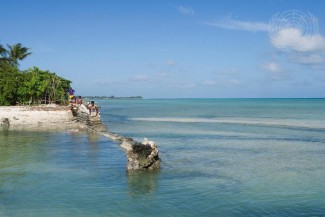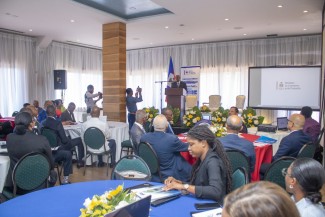|
|
|
International investment, and in particular foreign direct investment (FDI), has an important role to play in helping to achieve the Sustainable Development Goals. It can be a powerful international mechanism for mobilising the tangible and intangible assets (such as capital, technology, skills, access to markets) that are essential for sustainable growth and development.
Yet to fulfil this potential, FDI must increase substantially; it must be geared as much as possible towards sustainable development; and it must take place within a framework of international investment law and policy that is enabling, yet at the same time respectful of host governments’ own legitimate public policy objectives.
FDI flows reached their peak in 2007, at around US$2 trillion, dropping to US$1.2 trillion by 2009 as a result of the international financial crisis; at US$1.3 trillion in 2018, they are still far from having recovered to pre-crisis levels. While this represents a relatively small share – about 10% – of gross domestic capital formation, in individual countries this share can be even higher than domestic investment.
In 2018, FDI flows to LDCs were US$23.8 billion, roughly the average for the decade since the financial crisis, representing 1.8% of the global total. The top five recipients – Bangladesh, Myanmar, Ethiopia, Cambodia and Mozambique – accounted for over two-thirds of these flows, with Asian LDCs reaching a record high. China remained the top investor in LDCs in terms of FDI stock.
To help meet the investment needs of the future, FDI flows have to increase substantially. There is no apparent reason why they could not do so over the longer term, say to a level of US$4 or 5 trillion annually.
How to get there?
Improving FDI determinants
The key is to improve the three sets of FDI determinants – in other words, the factors that influence the locational decisions of international investors.
Most important among these determinants are the economic determinants, including the size of a host country’s market and its growth rate; the quality of a host country’s infrastructure, including its technological infrastructure; the quality of a host country’s human resources and supplier networks; the price of labour (for export-oriented investment, at least), and the availability of natural resources. Since improving the economic determinants is fundamental (and international investors are hesitant to sink substantial resources in the areas involved), official development assistance will continue to be important for the LDCs. In fact, improving the economic determinants is the single most important factor to leverage higher FDI flows.
The second set of determinants relates to the regulatory framework of host countries – it needs to be enabling. Obviously, the more favourable the regulatory framework, the more attractive a location becomes for investors, provided that the economic determinants are right. At the same time, though, any attempt to facilitate investment must be balanced against the development interests of host countries – for example, regulations protecting the environment may slow down the entry process yet remain desirable. On the other hand, for many more routine investment projects, client charters indicating timeframes within which required approvals should be issued may be useful.
Finally, there is a set of determinants that relates to the promotion of FDI, that is, enticing foreign investors to invest in a given country. This is the central mandate of investment promotion agencies: their task is to attract foreign investors, to help them in their entry and operations in host countries and to provide various after-investment services to retain investments, while at the same time giving policy advice to their governments and keeping the development interests of their economies in mind.
Importantly, while improving the economic determinants takes time, the regulatory framework and investment promotion can be improved relatively quickly. And this is central to investment facilitation. Moreover, investment facilitation becomes all the more important as the regulatory framework and investment promotion efforts become increasingly similar across countries.
Improving the economic FDI determinants is a long-term challenge that requires continuing attention, focussed on the traditional donors and regional and multilateral organisations active in this area, but also increasingly bringing in new and emerging donors from the developing world. The Belt and Road Initiative is one effort that is relevant here.
However, national regulatory frameworks and investment facilitation efforts can be improved in the short term, especially in the LDCs.
So what to do?
Addressing three challenges
The first challenge is to increase FDI flows through a concerted international effort to help the LDCs improve their FDI regulatory frameworks and investment promotion capacities. At present, there is no such international effort – along the lines of the Aid for Trade Initiative and especially the Trade Facilitation Agreement – in the FDI area. In fact, in a world of global value chains, these trade facilitation arrangements can help only so much, precisely because they address only one side of the coin, namely to increase trade, and do not address the other side of the coin, namely FDI.
In this situation – and given that the world FDI market is highly competitive – an additional and determined effort at investment facilitation can make the difference in being successful when seeking to attract foreign investors. This is where the “structured discussions” in the World Trade Organization (WTO) concerning a multilateral framework on investment facilitation for development become relevant, provided such a framework adds value to what is already been done nationally. And there are several ways in which such value-added could be envisaged, especially for LDCs.
One could be to extend the Aid for Trade Initiative to cover FDI and, hence, turn it into an Aid-for-Investment-and-Trade Initiative, perhaps even as part of a Sustainable Investment Facilitation Agreement to help LDCs to rapidly improve their regulatory frameworks as well as their capacity to promote investment – thereby increasing investment flows to these countries. LDCs would therefore be well advised actively to participate in the WTO structured discussions in order to steer them in a direction that benefits them most.
Encouraging higher FDI flows is, however, not enough.
The second challenge is to promote FDI that is geared as closely as possible towards sustainable development: sustainable FDI for sustainable development. This presents the challenge of defining “sustainable foreign direct investment.” A first approximation could be: “commercially viable investment that makes a maximum contribution to the economic, social and environmental development of host countries and takes place in the context of fair governance mechanisms,”as established by host countries and reflected, for instance, in the incentives they offer.
Yet any definition needs to be operationalised. So this challenge also involves developing an indicative list of sustainability characteristics, for consideration by governments seeking to attract sustainable FDI (and to encourage sustainable domestic investment). A Sustainable Investment Facilitation Agreement could provide for special facilitation measures for investors that are prepared to undertake sustainable FDI.
Such an indicative list of sustainability characteristics would also be a helpful tool for international arbitrators considering (as they should) the development impact of investment, as well as for identifying the mechanisms – beyond those deployed to attract FDI in general – that encourage the flow of sustainable investment and increase its benefits for host countries. And this leads to the third challenge.
The third challenge is to reform the international investment law and policy regime. National FDI rule-making increasingly takes place in the framework of international investment law and policy. For this reason, it is important to ensure that the international investment regime constitutes an enabling framework for encouraging the flow of sustainable FDI, while at the same time allowing governments to pursue their legitimate public policy objectives.
This requires asking several questions, including: How can the objective of sustainable development be made the lodestar of the international law and policy regime? What are the implications of such a concept for the regime’s rights and obligations? How will this affect the mechanism for settling disputes between investors and states? This last function is central to the regime and gives it its strength, yet it is precisely the existing dispute-settlement mechanism that is strongly questioned, especially by non-governmental organisations but also by a number of governments. Any reform needs to address this challenge adequately to avoid threatening the very legitimacy of the regime.
LDCs, in particular, have an interest in a reform of the investment law and policy regime as they need to benefit from it as much as possible while, at the same time, receiving assistance when it comes to international arbitration that can be costly in terms of both conducting arbitrations and awards rendered against LDCs. Establishing an Advisory Centre on International Investment Law would therefore be very desirable to help resource constrained countries – and all LDCs fall into this category – defend themselves adequately in international investment disputes.
Conclusion
LDC governments need to find ways and means to increase FDI flows within a reformed international investment law and policy regime to realize the sustainable development potential of this investment.
----------
This article is a revised version of Karl P. Sauvant, “How Can Foreign Direct Investment Fulfil Its Development Potential?” in OECD Development Co-operation Report 2016.
----------
* Karl P. Sauvant is Resident Senior Fellow, Columbia Center on Sustainable Investment, Columbia University.
--------
This policy series has been funded by the Australian Government through the Department of Foreign Affairs and Trade. The views expressed in this publication are the author’s alone and are not necessarily the views of the Australian Government.
If you would like to reuse any material published here, please let us know by sending an email to EIF Communications: eifcommunications@wto.org.



